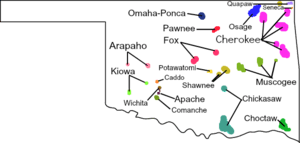Fox language facts for kids
Quick facts for kids Fox |
||||
|---|---|---|---|---|
| Meskwaki-Sauk-Kickapoo Meshkwahkihaki |
||||
| Native to | United States, Mexico | |||
| Region | Central Oklahoma, Northeastern Kansas, Iowa, and Coahuila | |||
| Ethnicity | 760 Meskwaki and Sauk and 820 Kickapoo in the US (2000 census) and 423 Mexican Kickapoo (2010 census) | |||
| Native speakers | 700: 250 Sauk and Fox and 400 Kickapoo in the US (2007–2015)e24 60 Kickapoo in Mexico (2020 census) |
|||
| Language family |
Algic
|
|||
| Writing system | Latin, Great Lakes Algonquian syllabics |
|||
| Linguist List | qes Mascouten | |||

Map showing the distribution of Oklahoma Indian Languages
|
||||
|
||||
The Fox language is an Algonquian language. It is also known by names like Mesquakie or Sauk-Fox. About a thousand people speak Fox. These speakers are from the Meskwaki, Sauk, and Kickapoo tribes. They live in parts of the Midwestern United States and northern Mexico.
Contents
What are the Dialects of Fox?
A dialect is a different form of a language. It is spoken in a certain area or by a certain group. The Fox language has three main dialects:
- Fox or Meskwakiatoweni (Meskwaki language)
- Sauk or Thâkiwâtowêweni (Thâkîwaki language)
- Kickapoo (also called Kikapú)
Some people think Kickapoo is its own language. If it is, then only 200 to 300 people still speak the Fox dialect. Another old dialect, Mascouten, is now extinct.
Why is the Fox Language Endangered?
Most people who speak Fox are older adults. This means the language is endangered. An endangered language is one that might disappear soon. This happens when fewer and fewer people learn and speak it.
Efforts to Save the Language
People are working hard to keep the Fox language alive.
- The tribal school at the Meskwaki Settlement in Iowa teaches children in both English and Fox. This helps new generations learn the language.
- In 2011, the Meskwaki Sewing Project started. This project brings mothers and girls together with older women. They sew traditional clothes and learn the Meskwaki language.
Many experts also study the Fox language. These include Ives Goddard and Lucy Thomason from the Smithsonian Institution. Amy Dahlstrom from the University of Chicago also does research.
How Does Fox Sound?
Like all languages, Fox has its own unique sounds. It has different consonant sounds and eight vowel sounds. These vowels can be short or long.
How Do You Count in Mesquakie?
Here are some numbers in the Mesquakie dialect:
| nekoti | one |
| nîshwi | two |
| nethwi | three |
| nyêwi | four |
| nyânanwi | five |
| nekotwâshika | six |
| nôhika | seven |
| neshwâshika | eight |
| shâka | nine |
| metâthwi | ten |
How is Fox Written?
The Fox language uses the Latin script today. This is the same alphabet English uses. But in the past, Fox was also written using two special writing systems. These were created by the people who spoke the language.
Fox I Writing System
The "Fox I" system is a type of abugida. This means that each written symbol stands for a consonant and a basic vowel sound. If you see a consonant by itself, it usually means it has an "a" sound after it. For example, the symbol for 'l' might mean 'pa'. To show other vowel sounds, dots were added to the consonant symbols.
Fox II Writing System
The "Fox II" system is a consonant-vowel alphabet. This means it has separate symbols for consonants and vowels. Some symbols looked like tally marks. For example, a cross mark '×' might mean 'a'. Other symbols were used for consonants like 't' or 's'.
Images for kids
-
Map showing the distribution of Oklahoma Indian Languages


